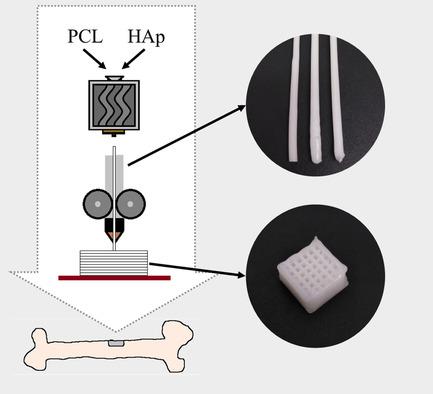当前位置:
X-MOL 学术
›
Adv. Eng. Mater.
›
论文详情
Our official English website, www.x-mol.net, welcomes your
feedback! (Note: you will need to create a separate account there.)
Development of Hot-Melt Extrusion Method to Produce Hydroxyapatite/Polycaprolactone Composite Filaments
Advanced Engineering Materials ( IF 3.4 ) Pub Date : 2021-09-07 , DOI: 10.1002/adem.202100820 Filip Zavřel 1 , Matěj Novák 1 , Jiřina Kroupová 1 , Celine Beveridge 1, 2 , František Štepánek 1 , Gabriela Ruphuy 1
Advanced Engineering Materials ( IF 3.4 ) Pub Date : 2021-09-07 , DOI: 10.1002/adem.202100820 Filip Zavřel 1 , Matěj Novák 1 , Jiřina Kroupová 1 , Celine Beveridge 1, 2 , František Štepánek 1 , Gabriela Ruphuy 1
Affiliation

|
The aim of this work is to develop a single-step process to produce hydroxyapatite/polycaprolactone (HAp/PCL) composite filaments for 3D printing of bone scaffolds by fused deposition modeling (FDM). The HAp/PCL composite filaments are produced by hot-melt extrusion, with direct in situ blending. For practical purposes, the effect of PCL particle size on filament homogeneity and printability is assessed between PCL in powder and pellet form. The effect of HAp content on processing parameters and filament properties is also evaluated. Filament extrudability, homogeneity, and shape consistency improve with increasing HAp content up to a threshold of 40 wt%. Furthermore, an optimal range of the composite melt viscosity for the extrusion process is defined. The produced filaments are successfully 3D printed by FDM and the resulting prototypes show improved compressive modulus and degradation rate with increasing HAp content. A cytocompatibility assay is conducted, which suggests an optimal HAp content to be less than 40 wt% in terms of cell viability, adhesion, and proliferation. The developed method offers several advantages, as it completely avoids the use of toxic solvents and enables the incorporation of very high HAp concentrations, further improving the chances of implementation of FDM for bone tissue regeneration medicine.
中文翻译:

热熔挤出法生产羟基磷灰石/聚己内酯复合长丝的发展
这项工作的目的是开发一种单步工艺,通过熔融沉积建模 (FDM) 生产用于 3D 打印骨支架的羟基磷灰石/聚己内酯 (HAp/PCL) 复合细丝。HAp/PCL复合长丝通过热熔挤出生产,直接原位共混。出于实际目的,PCL 粒径对长丝均匀性和可印刷性的影响在粉末和颗粒形式的 PCL 之间进行了评估。还评估了 HAp 含量对加工参数和长丝性能的影响。随着 HAp 含量增加到 40 wt% 的阈值,长丝的可挤出性、均匀性和形状一致性得到改善。此外,定义了挤出工艺的复合熔体粘度的最佳范围。生产的细丝通过 FDM 成功 3D 打印,所得原型显示出随着 HAp 含量增加而提高的压缩模量和降解率。进行了细胞相容性测定,这表明最佳的 HAp 含量在细胞活力、粘附和增殖方面小于 40 wt%。所开发的方法具有几个优点,因为它完全避免了有毒溶剂的使用,并且能够掺入非常高的 HAp 浓度,从而进一步提高了将 FDM 用于骨组织再生医学的机会。
更新日期:2021-09-07
中文翻译:

热熔挤出法生产羟基磷灰石/聚己内酯复合长丝的发展
这项工作的目的是开发一种单步工艺,通过熔融沉积建模 (FDM) 生产用于 3D 打印骨支架的羟基磷灰石/聚己内酯 (HAp/PCL) 复合细丝。HAp/PCL复合长丝通过热熔挤出生产,直接原位共混。出于实际目的,PCL 粒径对长丝均匀性和可印刷性的影响在粉末和颗粒形式的 PCL 之间进行了评估。还评估了 HAp 含量对加工参数和长丝性能的影响。随着 HAp 含量增加到 40 wt% 的阈值,长丝的可挤出性、均匀性和形状一致性得到改善。此外,定义了挤出工艺的复合熔体粘度的最佳范围。生产的细丝通过 FDM 成功 3D 打印,所得原型显示出随着 HAp 含量增加而提高的压缩模量和降解率。进行了细胞相容性测定,这表明最佳的 HAp 含量在细胞活力、粘附和增殖方面小于 40 wt%。所开发的方法具有几个优点,因为它完全避免了有毒溶剂的使用,并且能够掺入非常高的 HAp 浓度,从而进一步提高了将 FDM 用于骨组织再生医学的机会。











































 京公网安备 11010802027423号
京公网安备 11010802027423号